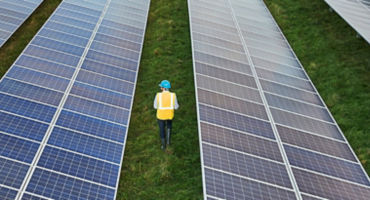As the negative impacts of climate change become apparent, investors are seeking ways to hedge portfolios against the potential long-term return drag from climate risks. We believe investing in assets correlated with rising demand for climate solutions can be an effective hedging approach.
Countering climate risk at the portfolio level is not straightforward. A dearth of relevant data, lack of disclosure standards, and inherent climate uncertainty make isolating assets at risk — and quantifying the degree and timing of those risks — challenging. Investors also lack clear-cut implementation options: It is not obvious which market indices are most exposed to climate-related risks, so identifying instruments to sell short is tricky. Finally, climate-related derivatives can be very narrow and difficult to implement at scale.
We think a more practical approach is to build dedicated exposure to climate solutions, which we expect will be positively correlated with climate change. By exposing a portfolio to climate-driven tailwinds, including the need for adaptation and mitigation, investors can potentially offset exposure from asset classes facing climate-related headwinds. Those assets at risk may include fossil-fuel-heavy utilities and equities, real assets, and some emerging market exposures.
Where is demand coming from?
We believe the combination of increasing climate events, stricter regulation, and shifting consumer and investor preferences will drive demand for climate-focused products and services. Because climate change is a long-term challenge for which society is woefully underprepared, we see the need for climate solutions as structural and likely to continue irrespective of prevailing political ideologies or regimes. We also expect appetite for carbon offsets to grow due to policy incentives and corporate efforts to neutralize difficult-to-abate emissions.
Increasing climate events
Our partners at Woodwell Climate Research Center project increasing probabilities for severe climate events, with meaningful physical and economic impacts. The risks of heat, drought, wildfires, water scarcity, hurricanes, and flooding are projected to worsen until at least mid-century. The price tag of climate disasters continues to rise. A 2019 UN report estimates adaptation costs to reach up to US$300 billion per year by 2030, and up to US$500 billion per year by 2050.1 Given the massive toll, governments will have no choice but to invest in climate-resilient infrastructure and technology.
Stronger policy and regulation
In response to climate change and the need to decarbonize, governments are taking action. Following the recent Climate Conference of the Parties in Glasgow, more than 150 countries have climate-action plans in place. Transition plans include commitments to reduce emissions to reach net-zero goals by 2050 or sooner, bolster energy-efficiency standards, curtail or cease deforestation, and, in some countries, enact carbon-pricing schemes. These top-down efforts should catalyze additional spending on carbon-efficient products and services, as well as continued demand for carbon offsets.
Shifting consumer and investor preferences
We expect that rising awareness, shifting values, and supportive demographics will propel climate demand as well. Millennial and Gen Z consumers represent over 40% of the US population and will dominate the workforce by 2030.2 A recent report by First Insight revealed that Gen Zers are willing to pay a premium for sustainable products, and Deloitte has found that climate change represents a chief concern among millennials, along with health care and unemployment.3 These insights are key given the enormous spending power of these large and growing cohorts, whose income levels will reach an estimated US$8.3 trillion in 2025 (millennials) and US$2 trillion by 2030 (Gen Z).4
The investment community is shifting along similar lines. The Glasgow Financial Alliance for Net Zero (GFANZ) now includes more than 450 asset managers, asset owners, banks, insurers, and investment consultants, representing more than US$130 trillion across 45 countries. We expect these stakeholders to increasingly pressure companies to be more energy efficient, manage physical risks to their real assets and supply chains, develop climate-friendly products, and be better stewards of the environment. All of this will require companies to spend more on climate-aware technologies and services.
Where will spending go?
Climate capital should flow to companies developing climate products and services, producers of material inputs for clean technologies, and carbon offsets. These fast-growing markets offer significant investment capacity. Today, we estimate the public equity climate opportunity set to include approximately 850 companies representing US$13.6 trillion in market value. In private equity, climate innovation is taking shape as an asset class in its own right, with more than 3,000 clean tech startups identified. This segment is attracting significant capital: In the first half of 2021, 600 climate tech startups raised US$60 billion, a 200% year-over-year increase.5
As demand for climate solutions increases, we anticipate the prices of key metal-commodity inputs such as cobalt, lithium, aluminum, copper, and nickel to appreciate commensurately. Finally, current carbon prices are likely too low to incentivize decarbonization consistent with 2050 net-zero goals. As policy changes drive carbon prices higher, we expect the number and size of carbon markets to increase as well.
Climate-hedge building blocks
To create a holistic climate hedge, we suggest building exposure to assets closely correlated with climate change, such as the following:











